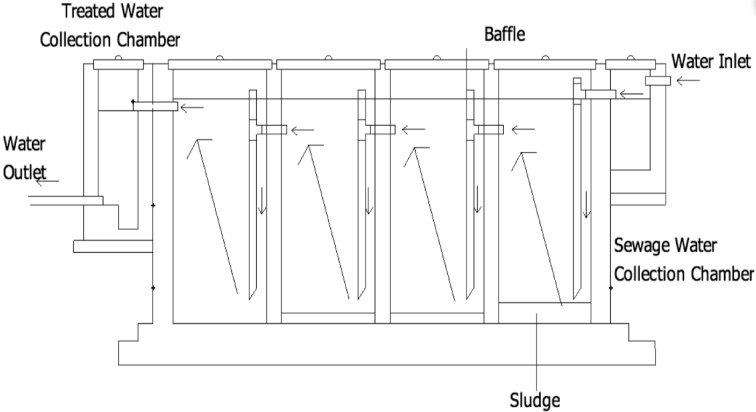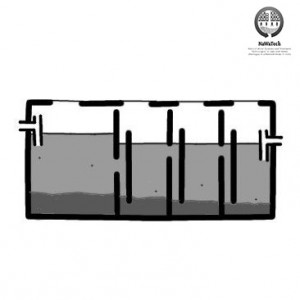Executive Summary
“The Anaerobic Baffle Reactor (ABR) is an improved septic tank, built with alternating baffles, which directs the wastewater to flow under and over it as the water moves from inlet to outlet” (SPUHLER 2010). Its design ensures increased contact time of the wastewater with the sludge and hence increases the efficiency. ABR was developed in the early 1980s at Stanford University. Due to its compact structure and possibility of integration into any construction designs, ABR is now considered as a key component in decentralised wastewater treatment systems.
| The contents of this factsheet are results of the Indo-European Project NaWaTech- “Natural Water Systems and Treatment Technologies to cope with Water Shortages in Urbanised Areas in India”, co-financed by the EC and the DST – India. |
Design and Construction Principles

The design concept of ABR is similar to the septic tank, as an anaerobic environment is created without any mechanical mixing. The factors, which govern the design of the ABR are – (1) Inflow parameters – quantity and quality, (2) HRT, which is dependent on the climatic characteristics and the inflow quality (CSE n.y.). “The majority of solids are removed in the sedimentation chamber at the beginning of the ABR, which typically represents 50 % of the total volume. The up flow chambers provide additional removal and digestion of organic matter: BOD may be reduced by up to 90 %, which is far superior to that of a conventional septic tank. As sludge is accumulating, desludging is required every 2 to 3 years. Critical design parameters include a hydraulic retention time (HRT) between 48 to 72 hours, up-flow velocity of the wastewater less than 0.6 m/h and the number of up-flow chambers (2 to 3)” (TILLEY et al. 2008). An ABR can easily be constructed underground as an RCC structure or brick masonry and will consume one square meter of area per cum of wastewater flow (CSE n.y.).
Operation and Maintenance
The tanks must be checked and ensured that they are watertight in order to avoid any infiltration. Also the scum and sludge levels have to be checked regularly for smooth and efficient functioning (adapted from TILLEY et al. 2008). Desludging has to be carried out (annually or once in two years) depending on the rate sludge formation, by using vacuum pumps. The tanks should not be emptied while desludging, as residual biomass is required for further treatment cycles. The flow to the system has to be maintained as per the design considerations to ensure the required level of treatments (adapted from SPUHLER 2010).
Cost Considerations
When ABR is installed as a part of a DEWATS (decentralised wastewater treatment system), it consumes about 40% of the system cost (CSE n.y.). The variability in the construction cost is dependent on the properties and composition of the soil, which is to be excavated. The costs of desludging will account to about Rs. 5000 for a 10 m3 tank, which is the only a yearly recurring expense. A reactor of 12 m3 volume (comprising 6 compartments of 2.0 m3 each) built at Adarsh College Badlapur in the year 2008 as a part of a DEWATS system had a cost of Rs.1,20,000 (about 2300 USD at that time) (ZIMMERMANN 2010).
Experiences in Europe and other Cities of the World
ABR is a suitable technology across the world, wherever the climatic conditions are suitable for anaerobic digestion. The temperature of tropics is generally suitable for anaerobic digestion processes, which has enabled the installation of ABR in many parts of the world. The wastewater treatment system installed at Khac Niem Commune, in Bac Ninh City, Vietnam includes an ABR along with a settling unit, anaerobic filter and polishing pond. The project implemented during the year 2009 treats a volume of 400 m3/day. The complete project cost was about 370,000 USD and the plant is successfully discharging the effluents as per the national quality regulations – COD < 80 mg/L and BOD <50 mg/L (BORDA 2010).
The DEWATS system at Manjuyod Public Market, in the Philippines has also integrated an ABR as one of the unit systems. The plant, constructed for a total volume of 40 m3/day at a cost of 120 million PhP (approx 108 million rupees), accepts wastewater from a vegetable market and a group of restaurants and the municipal health office. The influent water has a BOD of 600mg/L, which is being reduced to the discharge standards of <30mg/L (BORDA 2008).
Experiences in India
Anaerobic Baffle Reactors enjoy growing popularity as an anaerobic digestion process unit in decentralised treatment systems in many parts of the country. It has been installed a standalone treatment system, when there is no intended reuse and appropriate disposal options are available. Furthermore, it has also been implemented as part of DEWATS systems, where there are reuse opportunities. Being an underground installation that requires virtually zero open space, ABR is a perfect option for decentralised treatment in the urban scenario of India.
The wastewater treatment system implemented at Kamalini Kuteer resort by Ecosan Services Foundation (ESF) in 2009 has a combination of ABR and Anaerobic Filter. The resort is located around 60km south-west of Pune and is laying next to Kanindi River. The system receives approximately 5m3 wastewater per day with BOD of 240mg/L. The system has been giving stable performance (BOD>30mg/L) since its implementation.
During the construction of a bridge over Brahmaputra River at Bogibeel near Dibrugrah in Assam, ESF designed a decentralised wastewater treatment system for Hindustan Construction Company for the wastewater generated from the labour colony .The system was designed for 800 people equivalent and the anaerobic system has a capacity of 10 m3/day. The system has been running for the past 6 months and has shown stable treatment efficiency.
The decentralised water management system implemented at Adarsh Vidyaprasarak Sanstha’s College of Arts & Commerce, Badlapur, Maharashtra is working example of ABR. The institution hosts 2600 students and also acts a community centre for many programmes. With a daily wastewater production of 8 m3, the ABR was constructed for 12 m3 considering an HRT of 1.5 days. The total project cost came up to Rs.4.5 lakhs (approx. 8000 € at 2008 exchange rate) out of which 1.2 lakhs (approx. 2200 € at 2008 exchange rate) was for the ABR. The wastewater is treated as it flows through a biogas settler, anaerobic baffle reactor, upflow filter and a constructed wetland. Further, the water enters in the polishing pond from where it is being taken to reuse in irrigation purposes. The project was an EU funded AsiaProEco II and was executed by Badlapur Municipal Council with the support from Ecosan Services Foundation, seecon international gmbh and Paradigm Environmental Strategies Ltd. (ZIMMERMANN 2010).
An innovative concept of prefabricated DEWATS has been implemented for rehabilitation projects by CDD_BORDA in many parts of the world. These systems were installed in different parts of Tamil Nadu as a part of Tsunami rehabilitation project. These are systems made of FRP tanks and can easily be transferred by shipping containers, which has reduced the cost and time for construction considerably (BORDA 2009).
For more Information please visit: SPUHLER (2010): Anaerobic Baffled Reactor
| The research leading to these results has received funding from the European Union Seventh Framework Programme ([FP7/2007-2013]) under Grant Agreement N° [308336] and the Department of Science and Technology of the Government of India DS.O DST/IMRCD/NaWaTech/ 2012/(G). |
Decentralized Wastewater Treatment System - DEWATS
The wastewater from Manjuyod’s public market is treated in a decentralized system (DEWATS) composed of four different components: a settling tank; a anaerobic baffled reactor which reduces the BOD/COD content from 20% to 85%; a planted gravel filter; and finally a polishing pond.
BORDA (2008): Decentralized Wastewater Treatment System - DEWATS. Manjuyod Public Market. (= Sustainable Sanitation – Project Data Sheet ). Bremen: Bremen Overseas Research and Development Association (BORDA) URL [Accessed: 26.03.2010]EmSan - Emergency Sanitation
This source presents the DEWATS emergency sanitation service package, including options for different types of prefabricated materials, developed by BORDA.
BORDA (2009): EmSan - Emergency Sanitation. An innovative & rapidly installable solution to improve hygiene and health in emergency situations. (= Concept Note ). Bremen: Bremen Overseas Research and Development Association URL [Accessed: 31.05.2019]Technical Data Sheet for Khac Niem Commune
Cost Estimation for Planning and Designing of Decentralised Wastewater Treatment System
Decentralised wastewater treatment plant is a site-specific system. The different components of the system settler , anaerobic baffled reactor , planted filter and polishing pond are planned and designed according to the treatment requirement of the wastewater generated. Average water consumption for domestic usage in India is 135 Lpcd. 80% of the water which is used or consumed for domestic purposes comes out as a wastewater. An on-site wastewater treatment plant like DWWT can be installed to treat and recycle this wastewater in order to close the loop. The capacity of the system may vary from 1KLD to 100 KLD . For instance, DWWT system at CSE is designed for the capacity of 8 KLD to treat and reuse wastewater which is generated by the staff population of 150-200.
CSE (n.y): Cost Estimation for Planning and Designing of Decentralised Wastewater Treatment System. New Delhi: Centre for Science and Environment (CSE) URL [Accessed: 15.04.2013]Compendium of Sanitation Systems and Technologies
This compendium gives a systematic overview on different sanitation systems and technologies and describes a wide range of available low-cost sanitation technologies.
TILLEY, E., LUETHI, C., MOREL, A., ZURBRUEGG, C. and SCHERTENLEIB, R. (2008): Compendium of Sanitation Systems and Technologies. Duebendorf, Switzerland: Swiss Federal Institute of Aquatic Science and Technology (EAWAG) and Water Supply and Sanitation Collaborative Council (WSSCC) URL [Accessed: 15.02.2010] PDFDecentralised Wastewater Management at Adarsh College Badlapur, Maharashtra, India
This case study reports the development of an ecologically sound sanitation concept at the Adarsh Bidyaprasarak Sanstha's College of Arts & Commerce. In comprises separate urine collection and a DEWATS system for the treatment of black- and greywater consisting of biogas settler, an anaerobic baffled reactor, and anaerobic filter, a horizontal flow wetland and a polishing pond.
ZIMMERMANN, N. WAFLER, M. THAKUR, P. (2009): Decentralised Wastewater Management at Adarsh College Badlapur, Maharashtra, India. (= SuSanA - Case Studies ). Eschborn: Sustainable Sanitation Alliance (SuSanA) URL [Accessed: 22.09.2010]Compendium of Natural Water Systems and Treatment Technologies to cope with Water Shortages in Urbanised Areas in India
The Compendium of NaWaTech Technologies presents appropriate water and wastewater technologies that could enable the sustainable water management in Indian cities. It is intended as a reference for water professionals in charge of planning, designing and implementing sustainable water systems in the Indian urban scenario, based on a decentralised approach.
BARRETO DILLON, L. ; DOYLE, L. ; LANGERGRABER, G. ; SATISH, S. ; POPHALI, G. (2013): Compendium of Natural Water Systems and Treatment Technologies to cope with Water Shortages in Urbanised Areas in India. Berlin: EPUBLI GMBH URL [Accessed: 11.12.2015]http://www.nawatech.net/
This is the official webpage of the NaWaTech Collaborative Project, containing all key information related to the different case studies, activities and results of the project.


